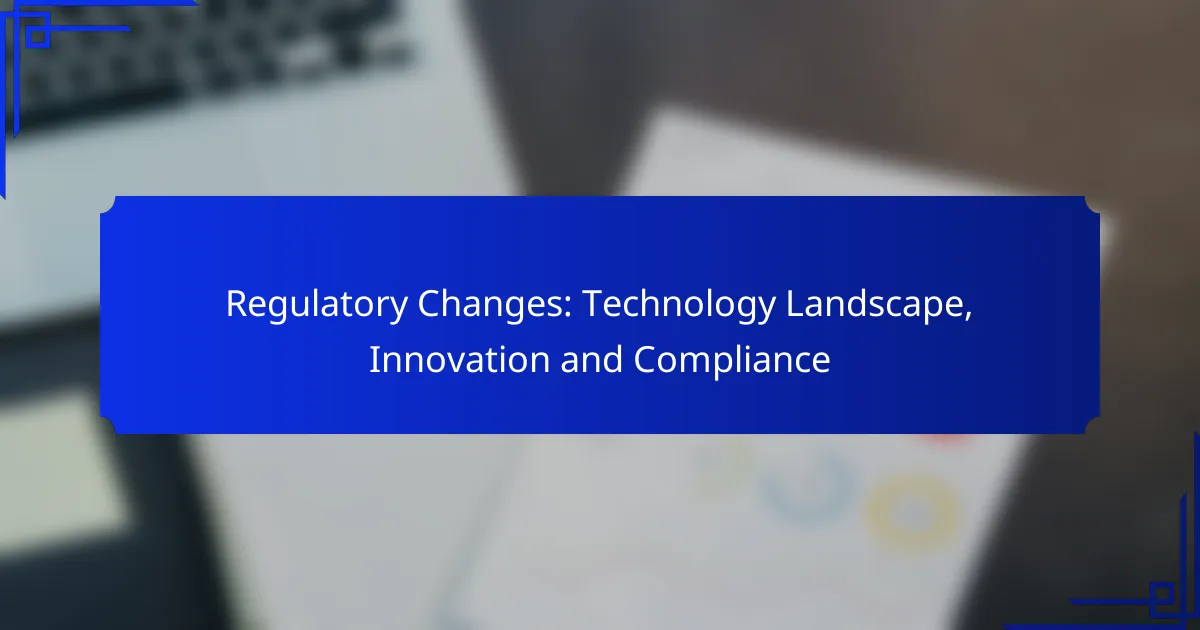The rapidly evolving technology landscape is significantly influenced by key regulatory changes aimed at enhancing data privacy, artificial intelligence compliance, and cybersecurity. As businesses adapt to these regulations, they must implement systematic approaches that incorporate technology, training, and expert guidance to ensure compliance and foster innovation. This dynamic environment drives the development of new technologies focused on improving compliance and data security across various industries.

What are the key regulatory changes impacting technology in the US?
Key regulatory changes in the US technology landscape focus on data privacy, artificial intelligence compliance, and cybersecurity. These regulations aim to enhance consumer protection, ensure ethical AI usage, and bolster defenses against cyber threats.
Data Privacy Regulations
Data privacy regulations in the US, such as the California Consumer Privacy Act (CCPA) and the Virginia Consumer Data Protection Act (VCDPA), set strict guidelines on how companies handle personal information. Businesses must provide transparency about data collection practices and allow consumers to opt out of data sales.
Organizations should implement robust data management strategies, including regular audits and employee training. Failure to comply can result in significant fines, often reaching into the millions of dollars.
AI Compliance Standards
AI compliance standards are emerging to ensure that artificial intelligence systems operate ethically and transparently. The National Institute of Standards and Technology (NIST) is developing a framework to guide organizations in assessing and mitigating risks associated with AI technologies.
Companies should prioritize fairness, accountability, and transparency in their AI systems. Regular assessments and updates to algorithms can help mitigate biases and enhance compliance with evolving standards.
Cybersecurity Legislation
Cybersecurity legislation, including the Cybersecurity Information Sharing Act (CISA), encourages organizations to share threat information to improve national security. This legislation emphasizes the need for proactive measures to protect sensitive data from cyberattacks.
Businesses must adopt comprehensive cybersecurity strategies, including incident response plans and employee training. Regularly updating software and conducting vulnerability assessments are critical steps to ensure compliance and protect against potential breaches.
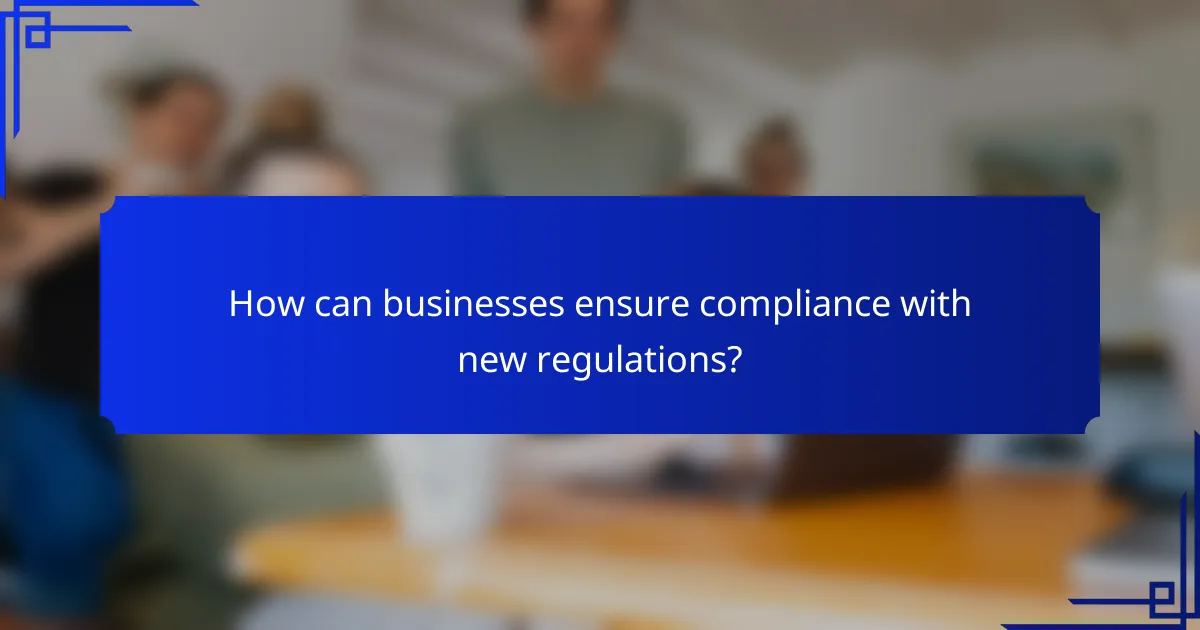
How can businesses ensure compliance with new regulations?
Businesses can ensure compliance with new regulations by adopting systematic approaches that include technology, training, and expert advice. These strategies help organizations navigate the evolving regulatory landscape effectively.
Implementing Compliance Software
Compliance software automates the tracking and reporting of regulatory requirements, making it easier for businesses to stay compliant. By integrating such tools, companies can manage documentation, monitor changes in regulations, and streamline audits.
When selecting compliance software, consider factors such as user-friendliness, integration capabilities with existing systems, and scalability. Popular options often include features like real-time alerts for regulatory changes and customizable reporting tools.
Regular Training Programs
Regular training programs are essential for keeping employees informed about compliance requirements and best practices. These programs should be tailored to specific roles within the organization to ensure relevance and effectiveness.
Consider conducting training sessions quarterly or bi-annually, supplemented by online resources for ongoing learning. Engaging formats such as workshops or interactive modules can enhance retention and application of compliance knowledge.
Consulting Legal Experts
Consulting legal experts is crucial for businesses to interpret complex regulations and understand their implications. Legal professionals can provide tailored advice and help develop compliance strategies that align with the organization’s goals.
Establish a relationship with legal advisors who specialize in your industry to ensure you receive timely insights on regulatory changes. Regular consultations can help preempt compliance issues and mitigate risks associated with non-compliance.

What innovations are emerging in response to regulatory changes?
Innovations in technology are increasingly being developed to meet evolving regulatory requirements across various industries. These advancements focus on enhancing compliance, improving data security, and streamlining data management processes.
Blockchain for Data Security
Blockchain technology offers a decentralized and tamper-proof method for securing sensitive data, making it an appealing option for organizations facing stringent regulatory standards. By utilizing cryptographic techniques, blockchain ensures that data integrity is maintained, which is crucial for compliance with regulations like GDPR and HIPAA.
Implementing blockchain can involve significant initial investment and technical expertise, but the long-term benefits include enhanced transparency and reduced risk of data breaches. Companies should assess their specific needs and consider pilot projects to evaluate blockchain’s effectiveness in their operations.
AI for Compliance Monitoring
Artificial intelligence (AI) is transforming compliance monitoring by automating the analysis of vast amounts of data to identify potential regulatory violations. AI systems can learn from historical data and adapt to new regulations, providing organizations with timely insights and alerts.
When integrating AI for compliance, businesses should focus on training models with relevant data and ensuring they are regularly updated to reflect the latest regulatory changes. This proactive approach can help reduce the risk of non-compliance and associated penalties.
Cloud Solutions for Data Management
Cloud solutions are increasingly being adopted for data management due to their scalability, flexibility, and cost-effectiveness. These platforms allow organizations to store and manage data in compliance with regulatory requirements while facilitating easier access and collaboration among teams.
When choosing a cloud provider, organizations should evaluate their compliance certifications, data encryption practices, and geographic data storage options to ensure alignment with local regulations. Regular audits and assessments of cloud services can help maintain compliance and secure sensitive information.
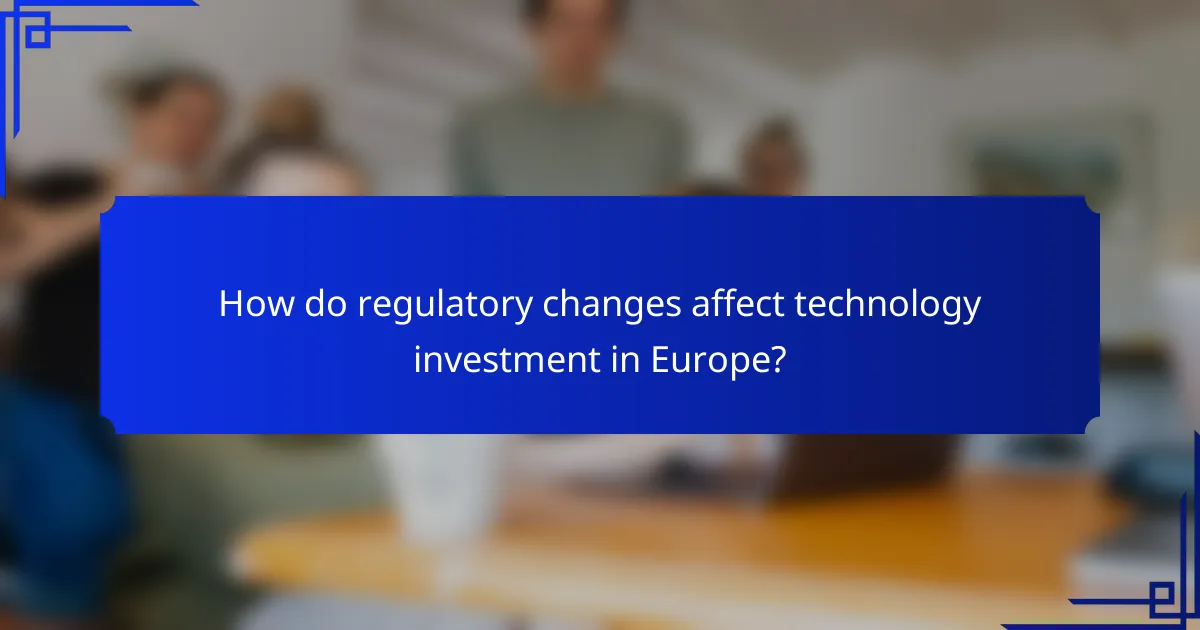
How do regulatory changes affect technology investment in Europe?
Regulatory changes significantly influence technology investment in Europe by driving demand for compliance solutions and reshaping funding priorities. As regulations evolve, businesses must adapt their technology strategies to meet new requirements, which often leads to increased investment in specific tech sectors.
Increased Funding for Compliance Tech
With the rise of stringent regulations like the General Data Protection Regulation (GDPR) and the Digital Services Act, companies are allocating more resources to compliance technology. This trend has resulted in a surge of funding for startups and established firms that offer solutions to help businesses navigate complex regulatory landscapes.
Investors are particularly interested in tools that automate compliance processes, enhance data security, and ensure transparency. These technologies not only mitigate risks but also help organizations avoid hefty fines, making them attractive investment opportunities.
Shift in Investment Strategies
Regulatory changes are prompting a shift in investment strategies across the technology sector. Investors are now prioritizing companies that demonstrate a strong commitment to compliance and ethical practices, often favoring those with robust governance frameworks.
Additionally, there is a growing interest in sectors such as fintech and health tech, where compliance is critical. Investors should consider the regulatory environment when evaluating potential investments, as companies that proactively address compliance may outperform their peers in the long run.
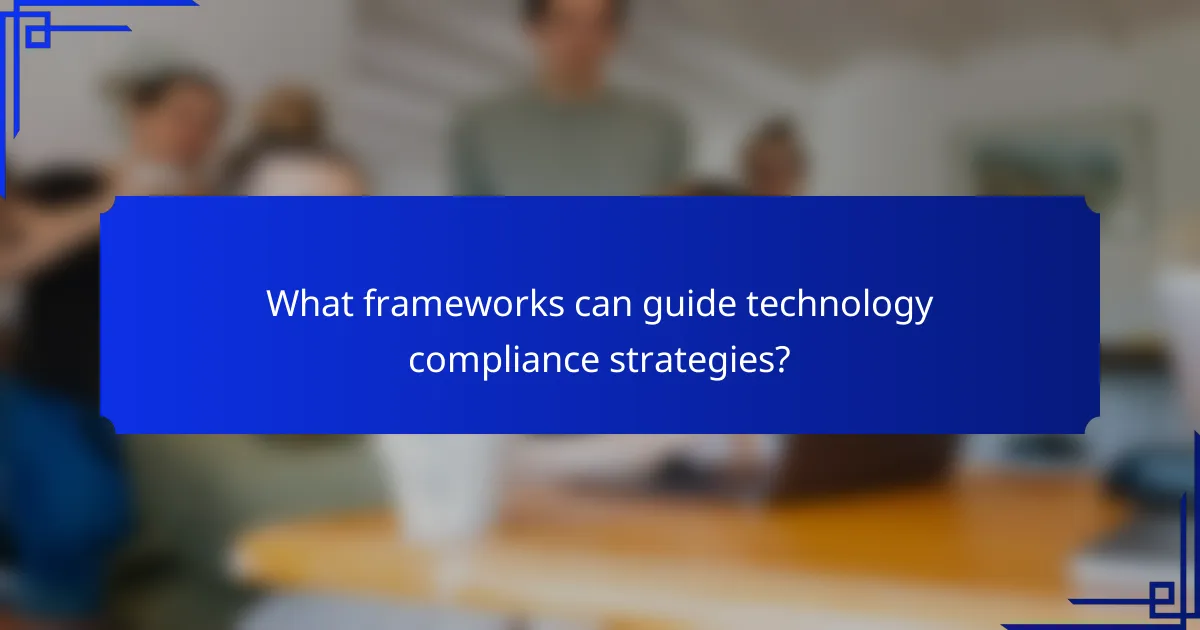
What frameworks can guide technology compliance strategies?
Frameworks for technology compliance strategies include risk assessment models and compliance checklists. These tools help organizations identify potential risks, ensure adherence to regulations, and streamline the compliance process.
Risk Assessment Models
Risk assessment models are systematic approaches to identifying and evaluating risks associated with technology use. They typically involve analyzing potential threats, vulnerabilities, and the impact of various scenarios on business operations.
Common models include qualitative assessments, which use descriptive categories, and quantitative assessments, which rely on numerical data. Organizations should choose a model that aligns with their risk appetite and regulatory requirements.
For example, a company might use a qualitative model to assess the risk of data breaches by categorizing threats as low, medium, or high. This helps prioritize resources for mitigation efforts effectively.
Compliance Checklists
Compliance checklists are practical tools that outline specific requirements organizations must meet to comply with regulations. These lists help ensure that all necessary steps are taken and can be tailored to different regulatory frameworks.
When creating a compliance checklist, include key areas such as data protection, user consent, and reporting obligations. Regularly updating the checklist is crucial to reflect changes in regulations and technology.
For instance, a checklist for GDPR compliance might include items like ensuring data subject rights are respected and that data processing activities are documented. This structured approach aids in maintaining compliance and reducing the risk of penalties.
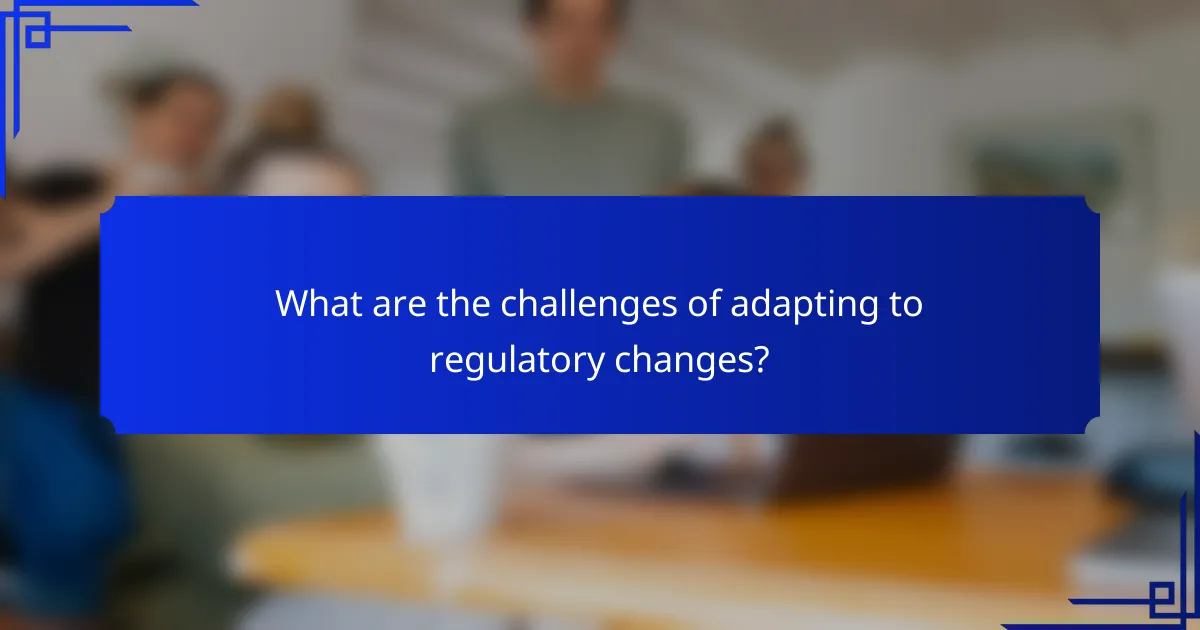
What are the challenges of adapting to regulatory changes?
Adapting to regulatory changes poses significant challenges for organizations, including compliance costs, operational disruptions, and the need for continuous monitoring. Companies must navigate complex regulations while ensuring that their technology and processes remain aligned with legal requirements.
Compliance Costs
Compliance costs can vary widely depending on the industry and the specific regulations involved. Organizations may face expenses related to legal consultations, technology upgrades, and employee training. For instance, companies in the financial sector might allocate substantial budgets to meet compliance standards like GDPR or PCI DSS.
To manage these costs effectively, businesses should conduct a thorough cost-benefit analysis. This analysis can help identify the most critical areas for investment and ensure that resources are allocated efficiently. Additionally, leveraging technology solutions can streamline compliance processes and reduce long-term expenses.
Operational Disruptions
Regulatory changes can lead to operational disruptions as companies adjust their workflows and systems. These disruptions may manifest as delays in product launches or changes in service delivery. For example, a new data protection regulation might require a company to overhaul its data management practices, impacting its overall operations.
To minimize disruptions, organizations should adopt a proactive approach by staying informed about upcoming regulatory changes. Establishing a dedicated compliance team can also facilitate smoother transitions and ensure that all departments are aligned with new requirements.
Continuous Monitoring
Continuous monitoring of regulatory changes is essential for maintaining compliance. Regulations can evolve rapidly, and organizations must be vigilant to avoid penalties. This requires implementing systems that can track changes in legislation and assess their impact on business operations.
Companies can benefit from using compliance management software that automates monitoring and reporting processes. Regular training sessions for employees can also ensure that everyone is aware of their responsibilities regarding compliance and understands the latest regulatory developments.
